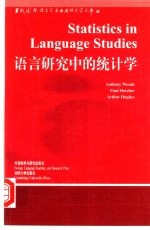图书介绍
语言研究中的统计学pdf电子书版本下载

- (英)Anthony Wooods等著;林连书导读 著
- 出版社: 北京:外语教学与研究出版社
- ISBN:7560019269
- 出版时间:2000
- 标注页数:327页
- 文件大小:11MB
- 文件页数:364页
- 主题词:
PDF下载
下载说明
语言研究中的统计学PDF格式电子书版下载
下载的文件为RAR压缩包。需要使用解压软件进行解压得到PDF格式图书。建议使用BT下载工具Free Download Manager进行下载,简称FDM(免费,没有广告,支持多平台)。本站资源全部打包为BT种子。所以需要使用专业的BT下载软件进行下载。如 BitComet qBittorrent uTorrent等BT下载工具。迅雷目前由于本站不是热门资源。不推荐使用!后期资源热门了。安装了迅雷也可以迅雷进行下载!
(文件页数 要大于 标注页数,上中下等多册电子书除外)
注意:本站所有压缩包均有解压码: 点击下载压缩包解压工具
图书目录
1 Why do linguists need statistics? 1
2 Tables and graphs 8
2.1 Categorical data 8
2.2 Numerical data 13
References 16
2.3 Multi-way tables 19
2.4 Special cases 20
Summary 22
Exercises 23
3 Summary measures 25
3.1 The median 27
3.2 The arithmetic mean 29
3.3 The mean and the median compared 30
3.4 Means of proportions and percentages 34
3.5 Variability or dispersion 37
3.6 Central intervals 37
3.7 The variance and the standard deviation 40
3.8 Standardising test scores 43
Summary 45
Exercises 46
4 Statistical inference 48
4.1 The problem 48
4.2 Populations 49
4.3 The theoretical solution 52
4.4 The pragmatic solution 54
Summary 57
Exercises 58
5 Probability 59
5.1 Probability 59
5.2 Statistical independence and conditional probability 61
5.3 Probability and discrete numerical random variables 66
5.4 Probability and continuous random variables 68
5.5 Random sampling and random number tables 72
Summary 75
Exercises 75
6 Modelling statistical populations 77
6.1 A simple statistical model 77
6.2 The sample mean and the importance of sample size 80
6.3 A model of random variation:the normal distribution 86
6.4 Using tables of the normal distribution 89
Summary 93
Exercises 93
7.1 Point estimators for population parameters 95
7 Estimating from samples 95
7.2 Confidence intervals 96
7.3 Estimating a proportion 99
7.4 Confidence intervals based on small samples 101
7.5 Sample size 103
7.5.1 Central Limit Theorem 103
7.5.2 When the data are not independent 104
7.5.3 Confidence intervals 105
7.5.4 More than one level of sampling 106
7.5.5 Sample size to obtain a required precision 107
7.6 Different confidence levels 110
Summary 111
Exercises 112
8 Testing hypotheses about population values 113
8.1 Using the confidence interval to test a hypothesis 113
8.2 The concept of a test statistic 117
8.3 The classical hypothesis test and an example 120
8.4 How to use statistical tests of hypotheses:is significance significant? 127
8.4.1 The value of the test statistic is significant at the 1 2.497769e-180vel 129
8.4.2 The value of the test statistic is not significant 130
Summary 130
Exercises 131
9 Testing the fit of models to data 132
9.1 Testing how well a complete model fits the data 132
9.2 Testing how well a type of model fits the data 137
9.3 Testing the model of independence 139
9.4 Problems and pitfalls of the chi-squared test 144
9.4.1 Small expected frequencies 144
9.4.2 The 2×2 contingency table 146
9.4.3 Independence of the observations 147
9.4.4 Testing several tables from the same study 149
9.4.5 The use of percentages 150
Summary 151
Exercises 152
10 Measuring the degree of interdependence between two variables 154
10.1 The concept of covariance 154
10.2 The correlation coefficient 160
10.3 Testing hypotheses about the correlation coefficient 162
10.4 A confidence interval for a correlation coefficient 163
10.5 Comparing correlations 165
10.6 Interpreting the sample correlation coefficient 167
10.7 Rank correlations 169
Summary 174
Exercises 174
11.1 Independent samples:testing for differences between means 176
11 Testing for differences between two populations 176
11.2 Independent samples:comparing two variances 182
11.3 Independent samples:comparing two proportions 182
11.4 Paired samples:comparing two means 184
11.5 Relaxing the assumptions of normality and equal var-iance:nonparametric tests 188
11.6 The power of different tests 191
Summary 192
Exercises 193
12 Analysis of variance-ANOVA 194
12.1 Comparing several means simultaneously:one-way ANOVA 194
12.2 Two-way ANOVA:randomised blocks 200
12.3 Two-way ANOVA:factorial experiments 202
12.4 ANOVA:main effects only 206
12.5 ANOVA:factorial experiments 211
12.6 Fixed and random effects 212
12.7 Test score reliability and ANOVA 215
12.8 Further comments on ANOVA 219
12.8.1 Transforming the data 220
12.8.2 'Within-subject'ANOVAs 221
Exercises 222
Summary 222
13 Linear regression 224
13.1 The simple linear regression model 226
13.2 Estimating the parameters in a linear regression 229
13.3 The benefits from fitting a linear regression 230
13.4 Testing the significance of a linear regression 233
13.5 Confidence intervals for predicted values 234
13.6 Assumptions made when fitting a linear regression 235
13.7 Extrapolating from linear models 237
13.8 Using more than one independent variable:multiple regression 237
13.9 Deciding on the number of independent variables 242
13.10 The correlation matrix and partial correlation 244
13.11 Linearising relationships by transforming the data 245
13.12 Generalised linear models 247
Summary 247
Exercises 248
14 Searching for groups and clusters 249
14.1 Multivariate analysis 249
14.2 The dissimilarity matrix 252
14.3 Hierarchical cluster analysis 254
14.4 General remarks about hierarchical clustering 259
14.5 Non-hierarchical clustering 261
14.6 Multidimensional scaling 262
14.7 Further comments on multidimensional scaling 265
14.8 Linear discriminant analysis 265
14.9 The linear discriminant function for two groups 268
14.10 Probabilities of misclassification 269
Exercises 271
Summary 271
15 Principal components analysis and factor analysis 273
15.1 Reducing the dimensionality of multivariate data 273
15.2 Principal components analysis 275
15.3 A principal components analysis of language test scores 278
15.4 Deciding on the dimensionality of the data 282
15.5 Interpreting the principal components 284
15.7 Covariance matrix or correlation matrix? 287
15.6 Principal components of the correlation matrix 287
15.8 Factor analysis 290
Summary 295
Appendix A Statistical tables 296
Appendix B Statistical computation 307
Appendix C Answers to some of the exercises 314
Index 319
文库索引 323